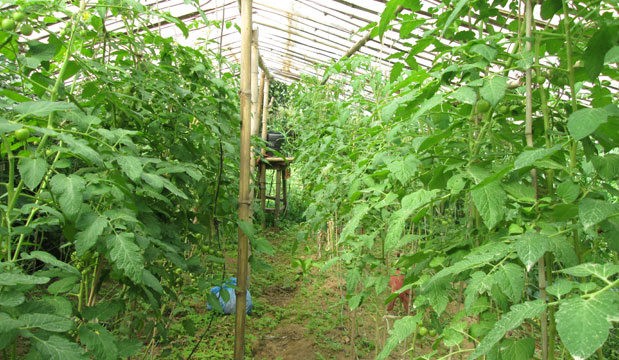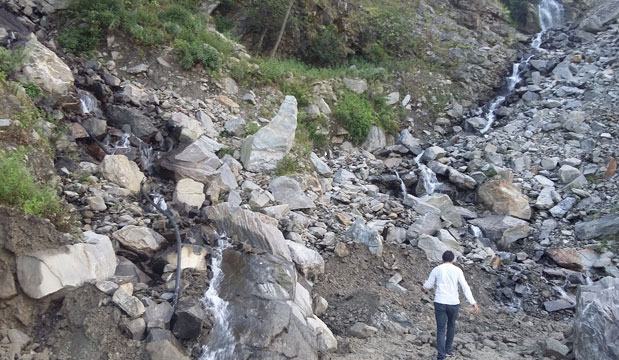By Sangita Dandekhya, ICIMOD
 A quake-hit house in Daibung VDC.
A quake-hit house in Daibung VDC.
As part of HI-AWARE research, I got a chance to explore Rasuwa, one of the mountainous districts of Central Nepal hardest hit by the 25 April 2015 earthquake and aftershocks from 27 Sept through October 1. During the four-day post-earthquake field visit to three Village Development Committees (VDCs) – Daibung VDC, Laharepauwa VDC and Bhorle VDC – I saw many cracked or demolished houses and buildings, and temporary shelters constructed using CGI-sheets. The majority of the mud-stone houses there have been destroyed, while many brick-cement buildings have been rendered unlivable. Displaced households have created their own temporary shelters using whatever material was available, including material salvaged from damaged houses; some of the people are living under tarpaulins. Various organisations, such as Lumanti, Parivartan Nepal, World Jewish Relief Fund, etc., have been working on issues pertaining to shelter, WASH and livelihoods, in the aftermath of the earthquakes.
The People’s Perceptions of Climate Variability and their Experiences
During the field visit, I tried to understand the people’s perceptions of climate change and climate variability and their impact on their lives. I conducted several Focused Group Discussions (FGDs) and informal interviews with key informants and farmers in Daibung VDC, Laharepauwa VDC and Bhorle VDC, all bordering the southern hills in Nuwakot. The FGDs revealed that the people have experienced various changes in the local climate. I asked the respondents about the timespan of crop-maturity compared to the past, and interestingly, almost all farmers talked about the early maturity of all crops, compared to how things were before.
The farmers have, for example, observed changed rainfall patterns in their village. During an FGD in Laharepauwa VDC, the farmers complained about the late monsoon this year (2015). “We don’t get water when we need, and then at other times, we get heavy, unnecessary rain. Both affect our crops badly. This year, we had a late monsoon, so we transplanted paddy in Bhadra (August). Last year we transplanted paddy on time. We could not cultivate all our land so we left some portions of our land barren.”
“There is now snowfall in Baisakh (April/May) and comparatively less snowfall during Magh-Paush (December/January),” said an older respondent during an FGD in Laharepauwa VDC.
We also tried to understand the local people’s perceptions of temperature variability. The majority of the respondents said they had experienced increases in temperature. Interestingly, they linked increased temperatures in the past two decades with the prevalence of mosquitoes now in the higher-altitude, cooler places like Chilime, Dhunche, etc.
 FGD in Laharepauwa VDC.
FGD in Laharepauwa VDC.
“Maize can now be harvested in two months,” said one of the farmers during an FGD at Daibung VDC. He added that the environmental changes, increases in temperature, application of chemical fertilisers and cultivation of hybrid crops might be the cause for the reduction in crop-maturity times. Some respondents complained about the drying up of the local spring sources in the village after the recent earthquakes.
“The tomato plants in my tunnel farm used to bear fruits that could touch the ground, but these days tomatoes grow a metre above the ground and their production has decreased compared to when I first started cultivating them, more than a decade ago,” said Bhuwa Prasad Ghimire, a farmer from Daibung-6.
Most of the farmers also complained about how the present improved varieties of crops did not produce seeds, unlike the local Nepali crop breeds they would use in the past. The farmers need to buy imported hybrid seeds, and they are worried about what will happen to them should seeds be unavailable in market in the future.
During an FGD in Laharepauwa VDC, Kesar Gurung, a young villager, said, “Hybrid crops have been cultivated in our village for the last 15 to 20 years, but we can’t get and store seeds from these imported hybrid crops. A famine may occur in the future if the country exporting hybrid seeds to us were to stop exporting them. The local breeds of crops – cucumbers, barela and pumpkins – are disappearing. The Government of Nepal needs to address this problem and it must establish seed banks.”
The respondents of an FGD in Bhorle VDC-5 complained about the disappearance of and decrease in local breeds of lentil crops like rahar and keshari and about the emergence of new pests and weeds in crops; they related this to the change in the local climate. “The temperatures have increased in our village. See, it should be cold now (September-October), but it’s still hot, and we wear light clothing,” said Dharma Bahadur Gurung, of Bhorle VDC-5.
 Tunnel Tomato farming in Daibung VDC.
Tunnel Tomato farming in Daibung VDC.
The respondents also mentioned that the taste of the millet had changed over time and they linked this to environmental changes and said that it could have been caused by climate change and the prolonged application of chemical fertilisers on crops.
During the field visit, I observed numerous active landslides in these VDCs and they were causing roadblocks in many places. Landslides are major impediments to access – for vehicles as well as for people on foot. According to our field findings, landslides, which occur frequently here, are a prominent problem in Rasuwa: every year, they destroy roads and cause huge losses to lives and property. Rasuwa’s hills have fragile geological formations, and thus heavy rainfall during the rainy months, especially during June, July and August, trigger the landslides, which obstruct and wash away roads, cultivated lands and houses. The landslide-prone VDCs in Rasuwa are Ramche, Thulogaun, Dandagaun, Dhunche and Yarsa. According to the respondents, the frequency of landslides had decreased remarkably in the last two years (2014-2015) in comparison to the past due to less rainfall during the monsoons.
 A road in Daibung VDC leading to Bhorle VDC, which has been washed away by a landslide
A road in Daibung VDC leading to Bhorle VDC, which has been washed away by a landslide
My interactions with the people in Rasuwa and my observations from the district have shown me that climate change is having a discernible impact on the livelihoods of the people living in the district’s mountains.
